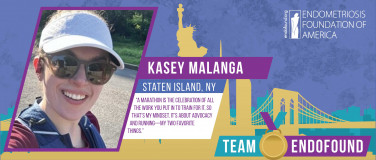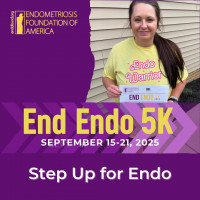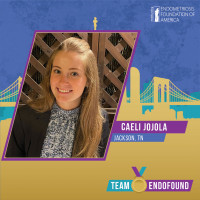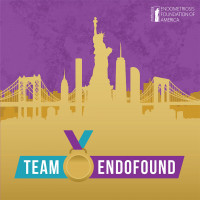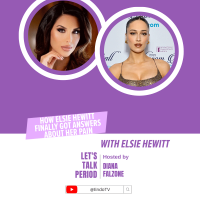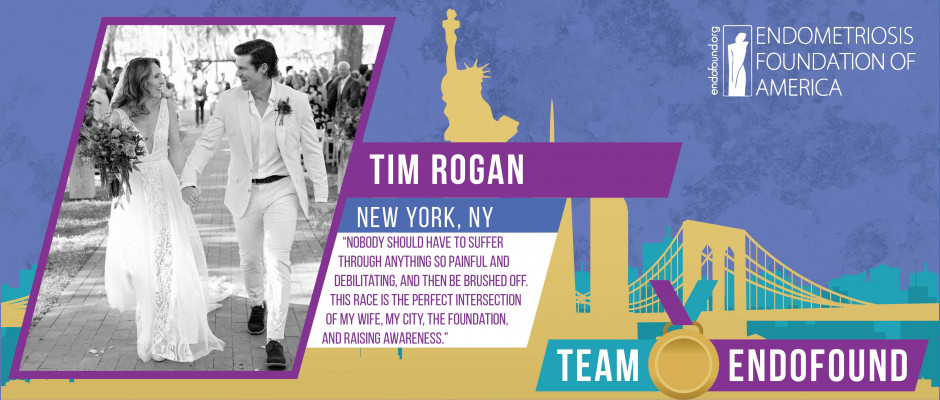
If Tim Rogan channels all of his frustration about the medical community’s lack of endometriosis awareness into his New York City Marathon run, he might win the whole thing, and in record time.
Okay, that may be a stretch—he’ll be happy to do it in under four hours. But that’s how fired up he and his wife Rachael are about their purpose for him running this race.
“We’ve become evangelical about sharing Rachael’s story,” Tim said. “We’re shocked by the number of people with symptoms who have been reaching out to us since Rachael was diagnosed and she began posting about it [on social media]. How are their doctors not telling them what’s causing their pain? How do doctors not know about this?”
Tim will run his first New York City Marathon on November 2 as part of EndoFound’s Team EndoStrong. The team is trying to raise $300,000 for the foundation. Tim’s personal goal was to raise $5,000. He shattered that in three days and has surpassed $10,000 with about two months to go.
“I’m just over the moon about that,” Tim said. “This whole opportunity is a bunch of different passions of mine converging into one. Running this race was a no-brainer.”
Naturally, stories that EndoFound publishes about endometriosis patients usually include the patients’ voices. But given Tim’s passion for what Rachael has been through, his energy when telling her story, and the fact that he’s running the marathon, this seemed to be an ideal time to share an endometriosis story entirely from a husband’s perspective.

Click Here To Support Tim Rogan's Marathon Fundraiser
“It’s truly been a saga for Rachael,” Tim said. “She’s dealt with so many symptoms her entire adult life—digestion issues, GI issues, pelvic pain, kidney stone-type pain, migraines, appendix irritation. But people would always say, ‘Oh, Rachael just has a sensitive tummy,’ or something like that.”
Rachael, 31, went on birth control as a teenager to alleviate her symptoms and remained on it until last year. Not wanting to be on any medication anymore, she stopped taking it last summer, a few months before she and Tim got married in October.
“A couple of months later, beginning around New Year’s, Rachael’s pain during ovulation aggressively got worse and worse and worse, to the point where she was living one of those debilitating endo stories that you hear about,” Tim said. “The big boiling point, though, was this past Easter.”
On that Sunday in April, while they were visiting Tim’s family in Massachusetts, Rachael’s appendix began throbbing. It wasn’t the first time she’d felt pain there.
“Anytime she felt that way, she’d be completely laid out, wait a few days, and then the pain would magically go away,” Tim said. “She’d been to so many gynecologists, ERs, and clinics, and they found nothing wrong. Rachael would walk out saying, ‘I feel like I’m crazy.’”
Tim and Rachael left the Easter festivities early and headed to their home in Piermont, New York, on the west side of the Hudson River. When the pain didn’t subside during their five-hour drive, they dropped off their luggage at home and headed to the hospital.
“They did a CT scan and other tests and said her appendix and everything else looked fine,” Tim said. “Basically, we walked away from it with, ‘Maybe you have a mild kidney stone.’”
While Tim was in the hospital’s waiting room during the tests, one of his best friends called him.
“He was calling about our guys’ golf trip coming up and asked how our Easter was going. I said, ‘Well, bud, it’s kind of a crappy one. We’re in the ER right now. Rachael has this symptom, and this symptom, and this symptom.’ And he says to me, ‘Sounds like she’s got endometriosis, bro.’ Then he says, and I quote, ‘You need to rip that [expletive] out of her!’”
As Tim would learn for the first time during that conversation, his friend’s wife, whom Tim had known for years, had endometriosis. Tim had never heard of it. “He says, ‘Tim, my wife went through every symptom you’re describing. She finally got diagnosed, had surgery, and her life changed.’”
Tim shared the information with Rachael.
“She said that her gynecologist once mentioned endometriosis, but said she didn’t think Rachael had it,” Tim said. “That would be unbelievably frustrating later because we’d eventually learn that the only concrete, slam-dunk way to test for endo is that the doctor has to cut you open, get in there, and get eyes on it.”
Tim and Rachael called their friend’s doctor immediately. Rachael got an appointment for the following week.
“Within a few minutes, the doctor says, ‘Yeah, these symptoms are textbook. I’m 99 percent sure that you have endometriosis,’” Tim said. “A few days later, Rachael has another consultation with him. Two weeks after that, on May 15, she’s in the OR having surgery.”
The doctor came out after completing the three-hour operation and told Tim that Rachael had stage III endometriosis. He excised it from several places, including her appendix, which was fused to her pelvic wall. That explained the pain she felt on Easter.
“We went from zero to 100 in less than a month,” Tim said. “It went from not even being on our radar and years of troubleshooting every symptom she had to this being it. It explained every bit of pain she’d been feeling all those years.”
Tim reflected on how everything transpired so quickly.
“It’s funny, but it’s not,” he said. “It took my dude friend, who called me to talk about our golf trip, to be the one to say, ‘Your wife has endometriosis.’ I’m thinking, ‘You’re an engineer in computer programming—you’re not even a doctor!’ But he was right.”
What upset Tim the most after the diagnosis was that Rachael’s gynecologist had not only told her that she didn’t have endometriosis, but she had also offered two remedies that would not have stopped the disease from growing.
“She told Rachael—and I know now that so many women with endo have heard this—that she could go back on the pill or get pregnant,” Tim said. “Seriously, those are your solutions? My wife is saying, ‘I’m having this pain,’ and you’re telling her, ‘You know what will fix that? Bring a child into this world.’”
Tim also noted the mental toll this journey had on both of them, especially the two weeks leading up to Rachael’s surgery.
“During those two weeks, she kept saying, ‘What if he gets in there and I don’t have endometriosis? What if this is all just a huge mistake?’ Not knowing was awful, and Rachael was looking for any reason not to go through with it,” Tim said. “And for me, I’m telling her that she needs to do this, but I felt like I was gambling with her body. What if she didn’t have it?”
They decided that if she didn’t have it, they could cross it off the list. And if they didn’t go through with the surgery and she did have it, it would only get worse. They also felt the odds were in their favor, given that the doctor was confident she had it, and he had been recommended to them by a close friend. The gamble paid off.
“The difference from before surgery to after is night and day,” Tim said. “It’s only been a few months, so her body is still recovering and adjusting, and she still gets flare-ups occasionally, but she’s doing well. She got her life back.”
Tim and Rachael now want to raise awareness about the disease to help women get diagnosed sooner, and Tim’s participation in the marathon is part of that mission. Tim is passionate about physical fitness, as well as everything else connected to this race—his wife, his city, the foundation, and the millions of women with the disease who are still seeking a diagnosis.
“Nobody should have to suffer through anything so painful and debilitating, and then be brushed off,” Tim said. “This race really is the perfect intersection of all these different things in my life, and to see what people have already donated—I’m flabbergasted and humbled by it.”
To support Tim Rogan in the New York City Marathon with a donation, visit https://give.endofound.org/fundraiser/6542470.



